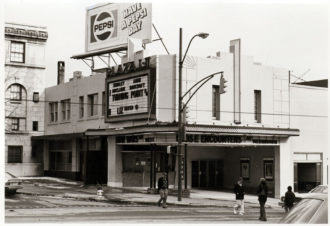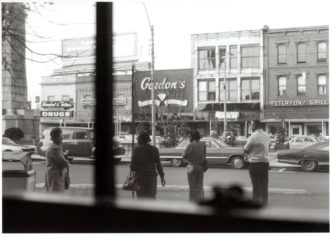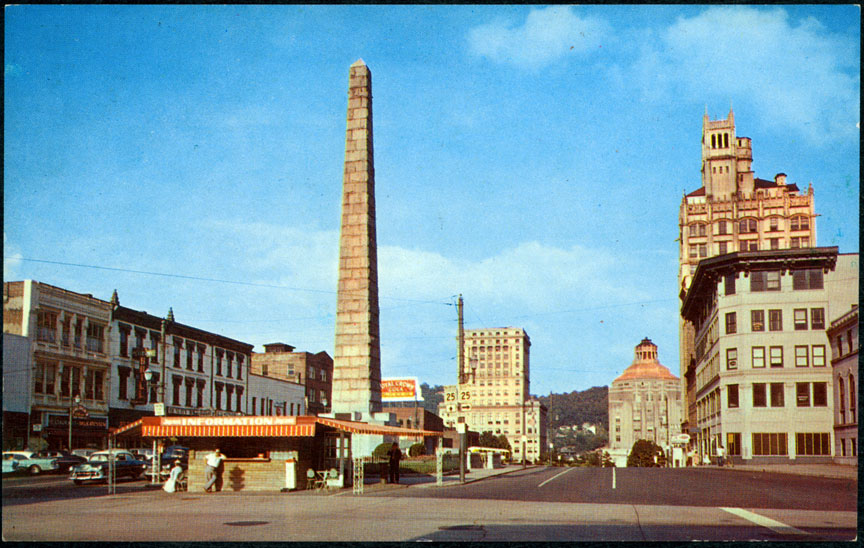In January 1962, The Asheville Citizen editorial board took a controversial stance. “We’re convinced it’s time to remove the Zeb Vance monument,” the paper wrote.
The board wasn’t alone in wanting to take the 75-foot-tall obelisk out of Pack Square, where it had stood since 1898. The proposal had originated with the Central Asheville Association, which had first broached the subject in 1958.
But unlike 21st-century debates over the monument — which ultimately led to its removal in May 2021 — the 1962 controversy had nothing to do with Vance’s role as a Confederate officer and slaveholder. It was about parking.
The idea was to convert the public square east of the monument into an off-street parking area with 36 spaces. “Properly beautified, the area could become a show spot,” the Citizen opined. “Properly utilized, it could be a means of easing traffic flow.”
The proposal met with a chilly reception from City Council and went nowhere. But members did agree Pack Square needed some sprucing up. “Shrubbery and a fountain would make the square a real beauty spot,” Councilman William F. Algary said, according to the paper.
If that sentiment seems familiar, it should. For more than six decades, the revitalization of Pack Square has been a recurring concern for elected officials and business leaders trying to draw people to the heart of the city. Some ideas died quickly; others dramatically transformed the area into what it is today.
As former Citizen-Times editor Bill Moore wrote in 2000: “It seems like only yesterday that we experienced the last redesign of Pack Square. Before that started, we were told that the new Pack Square would be a design for the ages.”
Although the ultimate fate of the Vance Monument remains uncertain, with the N.C. Supreme Court set to consider a lawsuit by a Confederate reenactment group challenging its removal, Asheville and Buncombe County are once again trying to figure out the future of the square. The “Pack Square Plaza Visioning and Improvements” effort specifically considers the stretch of land between Biltmore Avenue and Market Street.
Officials held several meetings last month seeking public input on the area’s future. A document reflecting that input is set to be published Friday, Jan. 6, and a public design workshop will take place Friday, Jan. 13. A draft vision plan is scheduled for release in the spring. (More information is available at avl.mx/c9m.)
As the community debates what should come next, Xpress takes a look back at some previous developments in Pack Square’s history.
Before the mall: 1960s-’70s
Jonathan Austin spent a lot of time around Pack Square as a kid in the late 1960s and early 1970s. Many days after school he would take a bus downtown, where his mother worked. He was supposed to do his homework or read in the old Pack Memorial Library, the building that now houses the Asheville Art Museum.
But what kid wants to sit in a stuffy library after being in school all day?
“So I would go out walking: around the square, down Patton Avenue, just around,” recalls Austin, who now lives in Waynesville. “I would study things. I would observe people and observe the city and observe the monument.”
In those days, before the Asheville Mall opened, Pack Square was a bustling center of city life, Austin says. He remembers staring in the window of Finkelstein’s, a pawn shop then at 7 SW Pack Square, and getting medicine at Barefoot and Tatum Drug Store, 2 N. Pack Square.

“The image I have is mainly of businessmen walking places, people coming uptown to shop or go to the library,” Austin says. “It was just the busiest place in town, it seemed.”
For Austin and many other young people, the crown jewel of the area was the Plaza Theater, a first-run cinema that sat next the library at 2 Biltmore Ave. Just entering the theater, with its thick carpeting and beautiful curtains, was a dramatic experience, he recalls.
Dan Pierce, now a history professor at UNC Asheville, has similarly fond memories of the theater, where he spent many Saturday afternoons in the 1960s. After decades of operating as a single theater, the Plaza was divided to feature two smaller screens in 1969.
“It was packed all the time,” recalls Shannon Hall, whose grandfather, Roy Gibbs, managed the cinema for many years. “Everybody went to the movies.”
Vacant buildings: 1970-’80s
The Asheville Mall opened on Tunnel Road in phases over 1972 and 1973. As a result, Belk, Ivey’s, Woolworth’s and other downtown stores pulled up stakes and moved to the new shopping center. Pack Square’s days as a vibrant business and shopping district were over for the time being.
By 1978, the Pack Memorial Library had left Pack Square and moved to its current location on Haywood Street. The Plaza Theater held on until 1985, but it was by then a shadow of its former glory as new suburban multiplexes took away customers.
Pierce describes losing the library and theater as one of downtown Asheville’s great tragedies.
“It’s kind of an interesting thing when the dominant feature of your central square, other than the Vance Monument, was Finkelstein’s, a pawn shop,” Pierce says. “That very much represented Asheville in the ’70s and into the ’80s. Downtown declined so much, and so much of it was boarded up.”
Another business that made headlines in the ’70s and ’80s was G’s Adult Book Store at 5 Pack Square. The shop often found itself under fire as officials tried to halt the sale of pornographic books and films: In 1975, for example, a Superior Court judge ruled that materials subpoenaed from the store were obscene.
“Nobody in their right mind was going downtown in those days because it was not a safe place. And there was nothing there anyway; no stores, not many restaurants,” Pierce says.
Not surprisingly, talk of revitalizing Pack Square was common during those decades.
In 1977, Akzona Inc. announced plans to build a multimillion-dollar corporate headquarters on North Pack Square. Construction of the building, designed by legendary architect I.M. Pei, would demolish several buildings on the square and reroute traffic. New trees and other landscaping additions also were part of the square’s new look.
The Citizen-Times hailed the project as “the most important event to happen to downtown Asheville in years,” and Pei told the newspaper the six-story building would “make” Pack Square.
But things didn’t turn out that way, at least at first. Akzona was a holding company for the Asheville-based American Enka Co. and other businesses, and the early 1980s were a brutal time for the textile industry.
Just a year after the building was completed in 1981, Akzona decided to sell it off amid an economic downturn that also led to massive layoffs. It stood vacant for four years.
In 1986, the Biltmore Co., which operates the Biltmore Estate, bought the building to use as its corporate offices. It still serves that purpose today, along with housing the local offices of financial services firm Merrill Lynch.
Pack Place: 1980s-’90s
In 1984, as the erstwhile Akzona building stood empty, the Community Arts Council received $20,000 from the N.C. General Assembly to explore possible uses of the vacant Pack Memorial Library building and the crumbling Plaza Theater, then on its last legs.
“Officials hope the library and theater buildings can be used as a public arts and cultural facility,” the Citizen-Times reported. “Among the possible uses are an art museum [and] space for local theater groups.”
The idea of an education, arts and science center in the heart of downtown would soon gather support from cultural groups, business leaders and others. In 1986, a $3 million bond referendum in support of the Pack Place project passed by a nearly 2-to-1 majority.
Officials initially planned to incorporate the theater building, which had stood since 1922, into Pack Place. But a survey showed the old movie house to be structurally unsafe, and it met the wrecking ball in 1988. The old library, on the other hand, was refurbished for use as the Asheville Art Museum, which opened in May 1992.
On July 4, 1992, eight years after the idea first surfaced, the remainder of the $15 million Pack Place project officially opened. Attractions included the Diana Wortham Theatre, Health Adventure children’s science museum and the Colburn Gem and Mineral Museum. The YMI Cultural Center, located just southeast of the square on South Market Street, was also renovated as part of the project.

“You could say that these are diamonds that came out of the rough … came out of dilapidated buildings and unoccupied spaces,” Mayor Ken Michalove said that day, according to the Citizen-Times. “These magnetic diamonds — Pack Place and YMI — will continue to draw our most important ingredient to downtown, people.”
Michalove proved to be right. In the decades that followed, restaurants and other businesses flocked to the square, and people followed. By the 1990s and into the 2000s, however, its vibe was decidedly different than it had been in the 1960s.
“Around Vance Monument on any given day, flocks of dreadlocked teenagers, skateboarders and other colorful forms of humanity are on display,” the Citizen-Times reported in 2000, adding that some local business owners and shoppers weren’t happy about their presence.
“There were a lot of hooligans hanging out in the square in the ’90s,” wrote Facebook user Flow Jones, when Xpress asked readers to share their memories of Pack Square. “I was one of them lol.”
Added Korah StGermain: “Back in the 90s when i first moved here, all the hippies touted how pack square was a mystical vortex. It was said an underground channel of quartz crystal connected vance to other mystical vortexes around the world.”
By the early 21st century, Asheville was being hailed nationally as a model of urban renewal, with delegations from other cities visiting for ideas to breathe life into their own struggling downtowns.
But not everyone was enthusiastic about the changes. Former Citizen-Times editor Moore bemoaned the passing of “old Pack Square” in 2000 as yet another revitalization effort was afoot.
“Then came new Pack Square and away went the parking, away went the old shops and stores, away went the theater and the lunchroom,” he wrote. “Instead we got a snazzy new office building designed by a Chinese architect with a huge reputation. … The folks designing the new, new Pack Square have not consulted me in the matter. But if they did, my reply would take the shape of a single sentence: ‘Bring back Barefoot and Tatum!'”
Editor’s note: Peculiarities of spelling and punctuation are preserved from the original documents.




Reckon that is how come they spent a great deal of time and money enshrouding and finally destroying the central monument after having spent a great deal of time and money having it refurbished only a few years prior?
. . . ” These magnetic diamonds — Pack Place and YMI — will continue to draw our most important ingredient to downtown, people.’ Michalove proved to be right. In the decades that followed, restaurants and other businesses flocked to the square, and people followed. ” . . .
Was Pack Place the “magnet” that led to the revitalization of downtown? Some local residents might question that version of downtown’s complicated history. Some residents might conclude that that the efforts of Peggy Gardiner, Wayne Caldwell, Julian Price, Roger McGuire, and John Cram were the more “magnetic diamonds.”